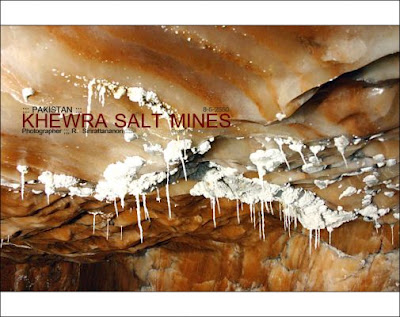


































Khewra Salt Mines

A view of the tunnel opened for tourists
Khewra Salt Mines is a salt mine located in Khewra, Jhelum District,
Salt has been mined at Khewra since 320 BC following discovery by Alexander's troops, in an underground area of about 110 square kilometres (42 sq mi). The main tunnel at ground level was developed by Dr. Warth in 1872 but has since been converted into a tourist resort. Khewra salt mine has estimated total of 220 million tonnes of rock salt deposits. The current production from the mine is 465,000 tons salt per annum.
The mine-head buildings have 19 stories, with 11 below ground. Only 50% salt is extracted and 50% is left as pillars to support the mountain. The salt-mine is 288 metres (945 ft) above sea level and extends around 730 metres (2,400 ft) inside the mountains from the mine-mouth. The cumulative length of all tunnels is more than 40 kilometres (25 mi).
Salt occurs in a Pre-Cambrian deposit in the form of an irregular dome-like structure. There are seven thick salt seams with a cumulative thickness of about 150 meters. At places the rock salt is 99% pure. Salt is transparent, white, pink, reddish to beef-color red. There are beautiful alternate bands of red and white color salt.

A small Mosque made of salt bricks inside the Khewra salt mines complex
Discovery of the mine
It is said that when Alexander visited
Afterwards this mine was wholly purchased by a local Raja and from that era to Independence of Pakistan this mine remained property of locally living Janjua Rajas who were sons of Raja Mal.
They are linked to the nearest place called Malot Fort constructed by [[Mughal,Tariq Mahmood as a Chief Project Director.
Tunnel design and layout
The current design and layout of the tunnels inside the mines was prepared by Chaudhry Niaz Ali Khan, a professional civil engineer then serving as Sub-Divisional Officer in the Mines Department, in the first quarter of the 20th century. From 1896 to 1900, Chaudhry Niaz Ali Khan studied engineering at The Thomason College of Civil Engineering (formerly
Miners' resistance to the British
In March 1849, the British captured the salt mines and a resistance movement began against the poor conditions and prices imposed upon the miners.
From 1849–62 there were strikes which were heavily suppressed and in 1872, new methods of measurement and pricing were introduced which increased workload. Mines were locked so miners couldn't leave without fulfilling their quotas. Men, women and children all worked in the mines and some children were even born in the mines due to the conditions imposed.
Further strikes were carried out by the workers from 1872–76. This time, the Chief mine engineer Dr. Warth got Delhi Head Office Collecter H.Wright to bring in British soldiers. Twelve of the workers representatives were shot at the front of the mines. Their names were:
§ Abdullah
§ Mohammad Sardar
§ Mohammad Hassan
§ Nawab
§ Allah Baksh
§ Khuda Baksh
§ Mohammad Abdulla
§ Jawaia
§ Paira
§ Mohammad Wahid
Their graves are outside the middle gates of the mines.
West Pakistan Salt Miners Labor Union
More recently the miners won an important environmental case against the mining company for the provision of unpolluted drinking water. This case is internationally recognised as important in showing the relationship between the environment and humanity.

Such a Nice and Informative Post. Thanks for Sharing
ReplyDeletePakistan Cargo Dubai